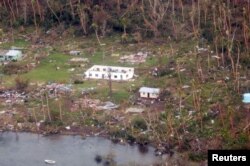Leaders from 130 nations are gathering at the United Nations to sign the historic climate deal reached in Paris last December.
The signing happens on the 46th anniversary of Earth Day. Since 1970, every year people around the world observe the day by doing different activities to clean up the environment.
On April 22, 1970, U.S. Senator Gaylord Nelson organized the first Earth Day with a “national teach-in on the environment.”
Earth Day Network says 20 million Americans gathered in the streets, parks and meeting halls “to demonstrate for a healthy, sustainable environment” in large rallies across the country.
This year, more than a billion people will celebrate the day by working for a clean environment.
U.N. Secretary-General Ban Ki-Moon has urged countries to take action to fix climate change.
“That is the only way which we can save this one, only, planet Earth.”
Island nations are very vulnerable to the stronger storms and rising sea levels brought on by climate change. One example is the Pacific island of Fiji. Super Cyclone Winston crashed into the island nation last February, killing 44 people and causing $1 billion in damage.
Fiji’s Prime Minister Josaia Bainimarama talked about their fear about the future:
“The frequency and intensity of extreme weather events such as Winston’s is increasing. And we all have to be fearful about what this means—not only for ourselves, but for future generations.”
It was last December, in Paris, France that world leaders worked out the details for the historic agreement. It limits the rise in global temperatures to well below two degrees Celsius.
It provides a way to reduce greenhouse gas emissions – those include pollution from factories and the burning of fossil fuels like coal. The agreement calls for a way to stop the effects of warming the planet. That includes moving towards using renewable energies, like wind and solar— or power from the sun.
Putting the plan into action will take several steps.
First, the 130 leaders gathering in New York Friday will sign the agreement. Then their governments must ratify – or formally approve it-- to put it into action.
Selwin Hart is director of the U.N. Climate Change Support Team.
He says the Paris Agreement must cross two important lines to become enforceable.
First, at least 55 parties to the United Nations Framework Convention on Climate Change must ratify the agreement. And those 55 countries must represent 55 percent of global greenhouse gas emissions.
China and the U.S. are the biggest contributors to the world’s global greenhouse gases. Together, the countries are responsible for about 40 percent of the world’s emissions.
Both the U.S. and China support the agreement. They are pushing for its early adoption by all the nations.
The target date to start the agreement is 2020. That could change. If all the countries ratify it quickly, it could happen this year, or in early 2017.
I’m Anne Ball.
Margaret Besheer reported on this story for VOANews.com. Anne Ball adapted this story for Learning English. Hai Do was the editor.
We want to hear from you. Write to us in the Comments Section.
_______________________________________________________
Words in This Story
sustainable - adj. involving methods that do not completely use up or destroy natural resources
vulnerable - adj. easily hurt or harmed physically, mentally, or emotionally
greenhouse gas emissions - n. gases released into the air that cause heat to be trapped and heat the planet
enforceable - adj. to make sure that people do what is required by (a law, rule, etc.)
global - adj. of the whole planet








